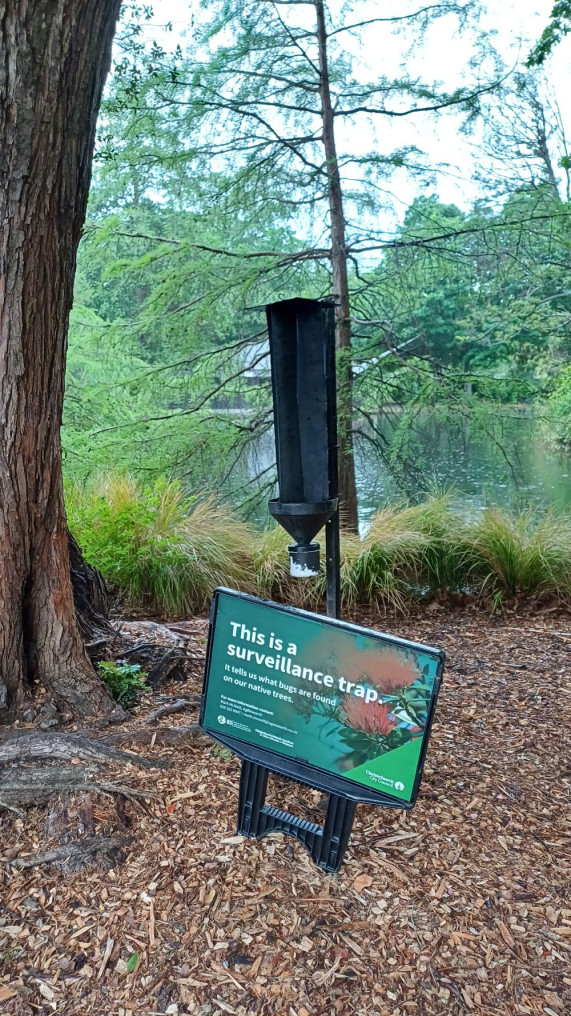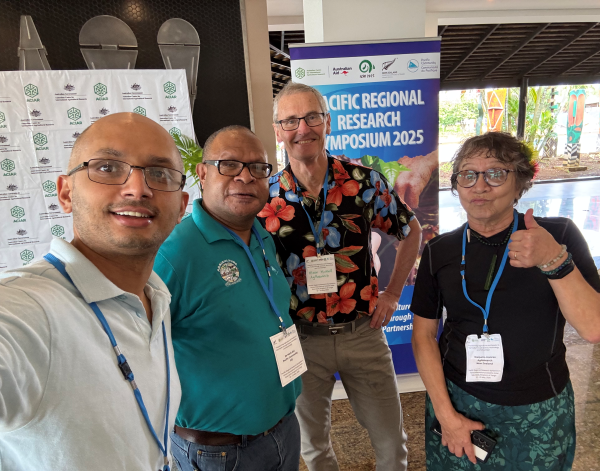Some of Aotearoa New Zealand’s most iconic native trees - including pōhutukawa and rātā - could be at risk from a group of two aggressive fungal pathogens Ceratocystis lukuohia and C. huliohia, if they reached the country. These pathogens were first identified on the island of Hawai‘i in 2014, have devastated native 'ōhi’a lehua trees (Metrosideros polymorpha) and are considered a serious emerging biosecurity threat to Myrtaceae globally.
The diseases caused by these two new pathogens are collectively called Rapid ‘Ōhi‘a Death (ROD) and have now spread to other islands in Hawaii.
‘Ōhi‘a is closely related to New Zealand’s pōhutukawa and rātā in the Myrtaceae family. The vectors and pathways for spread of ROD in Hawaii include bark beetles, humans, animals like cows and pigs, contaminated equipment, footwear, and dispersal of pathogen spores on the wind.
To get ahead of this potential threat a new research programme titled “Tackling the threat of invasive Ceratocystis species to Aotearoa New Zealand and the South Pacific” started in July 2024. Funded by B3 (Better Border Biosecurity), the programme is led by Plant & Food Research (PFR) in collaboration with AgResearch and Scion.
AgResearch scientist Mark McNeill says the work is focused on assessing how these pathogens might enter Aotearoa New Zealand, identifying which native and productive plants could be vulnerable, and preparing detection and response tools, are also areas of research.
“There’s real concern about the damage Ceratocystis could do here—particularly to taonga species like pōhutukawa and rātā, which hold deep cultural and ecological importance,” says Mark.
“We want to understand the most likely pathways for entry, how they could spread, and how best to respond if they’re detected.”
Mark’s research colleague and collaborator Waipaina Awarau said as a precaution the research team is supporting seed collection and storage for at-risk native Myrtaceae. Together with Teresa Waiariki (PFR) and in partnership with hapū and using culturally appropriate protocols, seeds of pōhutukawa and rātā have been collected from key sites. Some of these seeds were sent under strict biosecurity conditions to the United States Department of Agriculture (USDA) in Hilo, Hawai'i Island, where they were germinated and grown in high-security containment. This allowed scientists to safely expose seedlings to the two ROD-causing pathogens to assess susceptibility. This offshore collaboration with the USDA is providing valuable data on how native species may respond to infection.
“This could be our next Myrtle rust,” says Waipaina. “We’re mapping its spread across the Pacific, and it’s a big concern. The various hapū we’ve been working with have been very receptive.
"The hapū we work with have been open and supportive. While each hapū holds their own tikanga, we maintain respectful relationships guided by protocols and information to support a shared understanding. Mātauranga Māori is place-based and is central to our approach. Ultimately, hapū are the kaitieki and decision-makers when it comes to protecting these taonga species."
While only one strain of Ceratocystis is currently present in New Zealand (affecting kūmara), closely related strains are of high international concern. Several are listed as "unwanted organisms" under New Zealand law, and the International Plant Protection Convention recognises the group as a major global risk.
“C. lukuohia, if it arrived here, could be devastating - not only ecologically but culturally,” Mark warns.
In addition to human-mediated pathways, other potential vectors are under investigation.

Climatic modelling by emerging scientist Luna Hasna and Scientist Rebecca Campbel (PFR) have shown that particularly the top of the North Island and its east and west coasts have conditions for establishment of Ceratocystis species. Based on this, and because ambrosia beetles are known vectors of Ceratocystis species, a network of interception traps was placed.
AgResearch has set up traps in Christchurch (pictured above), Hamilton and on the East Coast to find out which bark and ambrosia beetles are associated with Metrosideros. Additional traps were deployed in areas identified as high risk by the modelling team, with Scion researchers Andrew Pugh, Darryl Herron and Nicolas Meurisse monitoring in Rotorua, Luna Hasna (PFR) covering the Auckland area, Teresa Waiariki focusing on the East Coast, Taranaki and Northland, and Jessica Fitzgerald and Emily Lillington (PFR) in the Nelson/Golden Bay region. Scion supplied the traps and lures, as well as identification keys for bark and ambrosia beetles, drawing on their extensive expertise in ambrosia beetle monitoring and forest biosecurity. Once captured, beetles are sent to Sarah Tallon, another emerging young researcher at PFR, who works under a tight schedule to process all samples. Her work focuses on testing for the potential presence of Ceratocystis, while also optimising culture and molecular detection methods and metabarcoding approaches. This coordinated effort is building a national picture of beetle presence and potential vector species to support early diagnosis and preparedness.
In recent trapping at Christchurch Botanic Gardens, Mark recorded high populations of bark beetles, especially an ambrosia beetle called fruit-tree pinhole borer (Xyleborinus saxesenii), closely associated with pōhutukawa and rātā. This beetle is known to be a key vector of ROD pathogens in Hawaii. Although no beetles have yet tested positive for Ceratocystis, their presence represents a plausible transmission risk.
Other risk factors unique to New Zealand include browsing animals such as possums and deer. These species can damage the roots and trunks of trees and create entry points for infection.
Community connection and Māori engagement remain at the heart of the programme.
“The support from mana whenua has been critical,” says Mark. “When we talk about the risk of losing rātā or pōhutukawa, there’s deep understanding. This is not just a Māori loss—the pōhutukawa is iconic to all New Zealanders.”
Recently, Mark and Waipaina presented their research at the South Pacific Research Conference in Tonga, highlighting both the technical and cultural aspects of their work. The project has also begun engaging with Fiji National University and is working toward supporting a Master's student to carry out aligned research (2025-2026), helping to build regional capability and strengthen biosecurity preparedness across the South Pacific.

Left to right: Sulav Paudel (AgResearch), a delegate from PNG Forest Research, Mark McNeill (AgResearch) and Waipaina Awarau (AgResearch) at a recent Pacific biosecurity conference in Tonga. The event brought together researchers and officials from across the region to strengthen collaboration on biosecurity challenges.
“While the direct risk from Hawai‘i is well understood, we need to stay alert to secondary invasion routes—such as via Tonga or New Caledonia,” Mark says. “It’s not inevitable the pathogen will arrive, but vigilance is key.”
The project builds on a previous B3-funded programme, “Understanding the risk of rapid ʻōhiʻa death to Aotearoa New Zealand and the South Pacific” (2021–2023). It also connects with Mark’s earlier B3 work on sentinel plants, linking with botanic gardens and arboreta across Australia, the UK, Europe, and the US. These collaborations have provided Aotearoa New Zealand with access to a global intelligence network, providing foresight into emerging threats and gives the country a head-start in biosecurity preparedness. They also help maintain a flow of knowledge on emerging Ceratocystis species and their global distribution.
Project leader Virginia Marroni (PFR) says the programme brings together expertise in biosecurity risk modelling, diagnostics, plant pathology, vector–pathogen interactions, and Māori engagement across three Crown Research Institutes (CRIs), soon to be amalgamated into a single Public Research Organisation (PRO). While the immediate focus is on Ceratocystis, she notes that the threat it represents reflects a broader global pattern of emerging pathogens. “Our work is about being ready, not just for this specific pathogen, but for whatever may come next,” says Virginia. “The tools we’re developing, the surveillance networks we’re building, and the relationships we’re strengthening across science, iwi, and international partners will serve us well in responding to future threats to Aotearoa’s forests, crops, and ecosystems.”